Solar eclipse of June 30, 1992
A total solar eclipse occurred on June 30, 1992. A solar eclipse occurs when the Moon passes between Earth and the Sun, thereby totally or partly obscuring the image of the Sun for a viewer on Earth. A total solar eclipse occurs when the Moon's apparent diameter is larger than the Sun's, blocking all direct sunlight, turning day into darkness. Totality occurs in a narrow path across Earth's surface, with the partial solar eclipse visible over a surrounding region thousands of kilometres wide. Totality was visible in southeastern Uruguay and southern tip of Rio Grande do Sul, Brazil.
| Solar eclipse of June 30, 1992 | |
|---|---|
 Map | |
| Type of eclipse | |
| Nature | Total |
| Gamma | -0.7512 |
| Magnitude | 1.0592 |
| Maximum eclipse | |
| Duration | 321 sec (5 m 21 s) |
| Coordinates | 25.2°S 9.5°W |
| Max. width of band | 294 km (183 mi) |
| Times (UTC) | |
| Greatest eclipse | 12:11:22 |
| References | |
| Saros | 146 (26 of 76) |
| Catalog # (SE5000) | 9491 |
Images
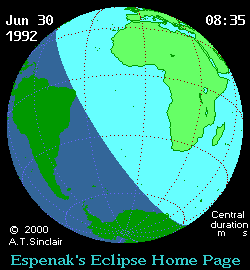
Related eclipses
Eclipses of 1992
Solar eclipses of 1990–1992
This eclipse is a member of a semester series. An eclipse in a semester series of solar eclipses repeats approximately every 177 days and 4 hours (a semester) at alternating nodes of the Moon's orbit.[1] This semester series contains only 7 eclipses.
| Solar eclipse series sets from 1990–1992 | ||||||
|---|---|---|---|---|---|---|
| Ascending node | Descending node | |||||
| Saros | Map | Gamma | Saros | Map | Gamma | |
| 111 | 1989 February 6 | -1.56550 | 116 | 1989 August 1 | 1.58396 | |
| 121 | 1990 January 26 Annular | -0.94571 | 126 | 1990 July 22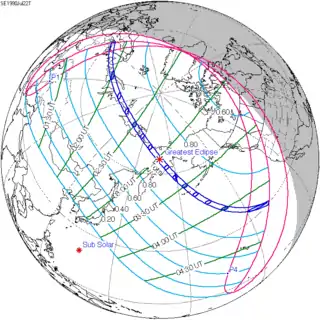 Total | 0.75972 | |
| 131 | 1991 January 15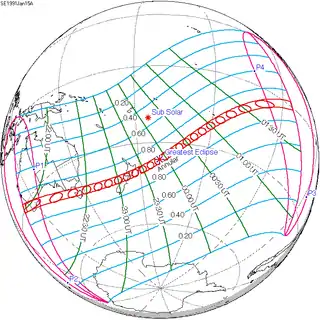 Annular | -0.27275 | 136 From Playas del Coco | 1991 July 11 Total | -0.00412 | |
| 141 | 1992 January 4 Annular | 0.40908 | 146 | 1992 June 30 Total | -0.75120 | |
| 151 | 1992 December 24 Partial | 1.07106 | 156 | 1993 June 20 | -1.56439 | |
Saros 146
It is a part of Saros cycle 146, repeating every 18 years, 11 days, containing 76 events. The series started with partial solar eclipse on September 19, 1541. It contains total eclipses from May 29, 1938 through October 7, 2154, hybrid eclipses from October 17, 2172 through November 20, 2226, and annular eclipses from December 1, 2244 through August 10, 2659. The series ends at member 76 as a partial eclipse on December 29, 2893. The longest duration of totality was 5 minutes, 21 seconds on June 30, 1992.
| Series members 21-37 occur between 1901 and 2200: | ||
|---|---|---|
| 21 | 22 | 23 |
 May 7, 1902 |
 May 18, 1920 |
 May 29, 1938 |
| 24 | 25 | 26 |
 June 8, 1956 |
 June 20, 1974 |
 June 30, 1992 |
| 27 | 28 | 29 |
 July 11, 2010 |
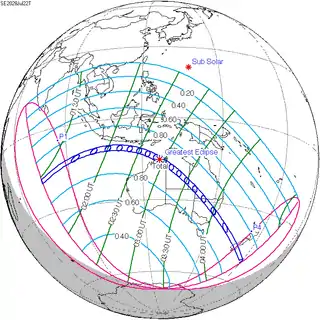 July 22, 2028 |
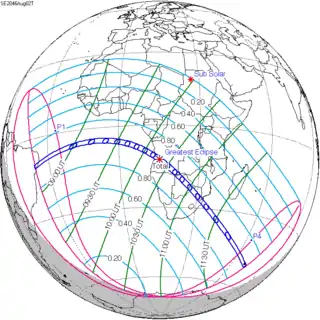 August 2, 2046 |
| 30 | 31 | 32 |
 August 12, 2064 |
 August 24, 2082 |
 September 4, 2100 |
| 33 | 34 | 35 |
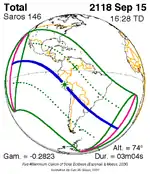 September 15, 2118 |
 September 26, 2136 |
 October 7, 2154 |
| 36 | 37 | |
 October 17, 2172 |
 October 29, 2190 | |
Inex series
This eclipse is a part of the long period inex cycle, repeating at alternating nodes, every 358 synodic months (≈ 10,571.95 days, or 29 years minus 20 days). Their appearance and longitude are irregular due to a lack of synchronization with the anomalistic month (period of perigee). However, groupings of 3 inex cycles (≈ 87 years minus 2 months) comes close (≈ 1,151.02 anomalistic months), so eclipses are similar in these groupings. In the 19th century:
• Solar Saros 140: Total Solar Eclipse of 1818 Oct 29
• Solar Saros 141: Annular Solar Eclipse of 1847 Oct 09
• Solar Saros 142: Total Solar Eclipse of 1876 Sep 17
| Inex series members between 1901 and 2100: | ||
|---|---|---|
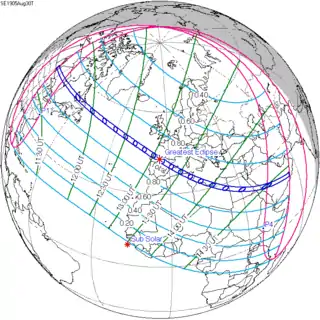 August 30, 1905 (Saros 143) |
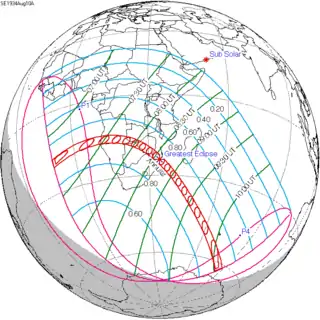 August 10, 1934 (Saros 144) |
 July 20, 1963 (Saros 145) |
 June 30, 1992 (Saros 146) |
 June 10, 2021 (Saros 147) |
 May 20, 2050 (Saros 148) |
 May 1, 2079 (Saros 149) |
||
In the 22nd century:
Solar Saros 150: Partial Solar Eclipse of 2108 Apr 11
Solar Saros 151: Annular Solar Eclipse of 2137 Mar 21
Solar Saros 152: Total Solar Eclipse of 2166 Mar 02
Solar Saros 153: Annular Solar Eclipse of 2195 Feb 10
Tritos series
This eclipse is a part of a tritos cycle, repeating at alternating nodes every 135 synodic months (≈ 3986.63 days, or 11 years minus 1 month). Their appearance and longitude are irregular due to a lack of synchronization with the anomalistic month (period of perigee), but groupings of 3 tritos cycles (≈ 33 years minus 3 months) come close (≈ 434.044 anomalistic months), so eclipses are similar in these groupings.
| Series members between 1901 and 2100 | |||
|---|---|---|---|
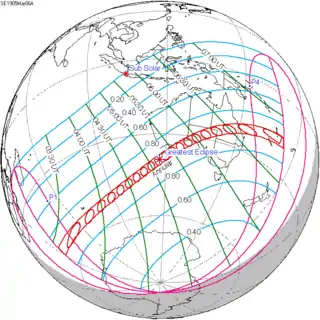 March 6, 1905 (Saros 138) |
 February 3, 1916 (Saros 139) |
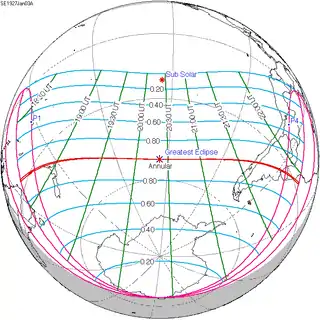 January 3, 1927 (Saros 140) | |
 December 2, 1937 (Saros 141) |
 November 1, 1948 (Saros 142) |
 October 2, 1959 (Saros 143) | |
 August 31, 1970 (Saros 144) |
 July 31, 1981 (Saros 145) |
 June 30, 1992 (Saros 146) | |
 May 31, 2003 (Saros 147) |
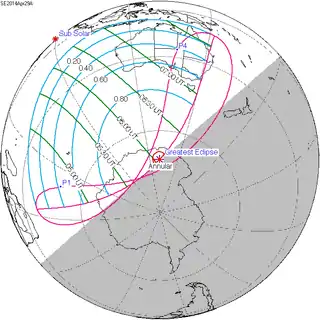 April 29, 2014 (Saros 148) |
 March 29, 2025 (Saros 149) | |
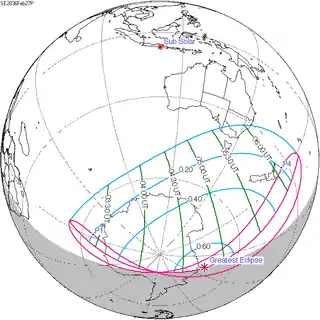 February 27, 2036 (Saros 150) |
 January 26, 2047 (Saros 151) |
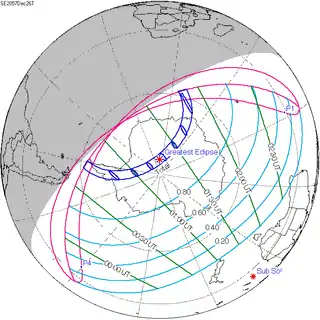 December 26, 2057 (Saros 152) | |
 November 24, 2068 (Saros 153) |
 October 24, 2079 (Saros 154) |
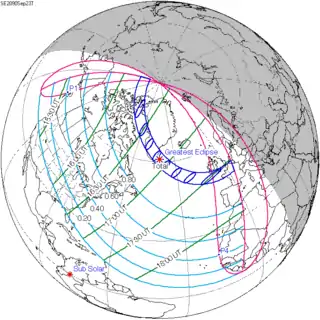 September 23, 2090 (Saros 155) |
|
Metonic series
The metonic series repeats eclipses every 19 years (6939.69 days), lasting about 5 cycles. Eclipses occur in nearly the same calendar date. In addition, the octon subseries repeats 1/5 of that or every 3.8 years (1387.94 days). All eclipses in this table occur at the Moon's descending node.
| 22 eclipse events between September 12, 1931 and July 1, 2011. | ||||
|---|---|---|---|---|
| September 11-12 | June 30-July 1 | April 17-19 | February 4-5 | November 22-23 |
| 114 | 116 | 118 | 120 | 122 |
 September 12, 1931 |
 June 30, 1935 |
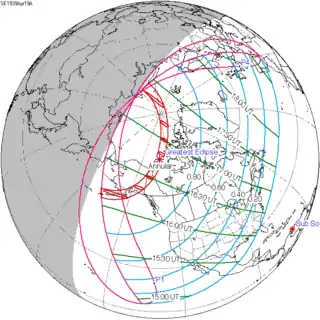 April 19, 1939 |
 February 4, 1943 |
 November 23, 1946 |
| 124 | 126 | 128 | 130 | 132 |
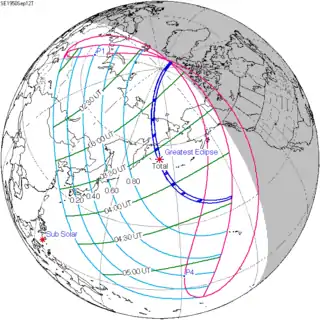 September 12, 1950 |
 June 30, 1954 |
 April 19, 1958 |
 February 5, 1962 |
 November 23, 1965 |
| 134 | 136 | 138 | 140 | 142 |
 September 11, 1969 |
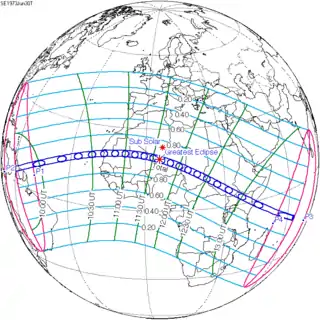 June 30, 1973 |
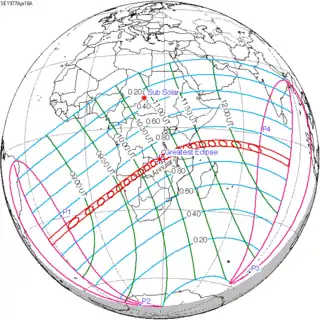 April 18, 1977 |
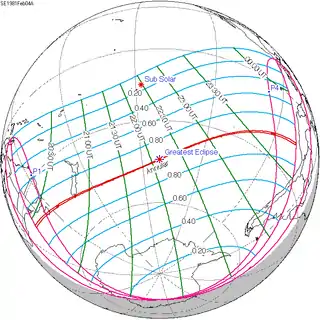 February 4, 1981 |
 November 22, 1984 |
| 144 | 146 | 148 | 150 | 152 |
 September 11, 1988 |
 June 30, 1992 |
 April 17, 1996 |
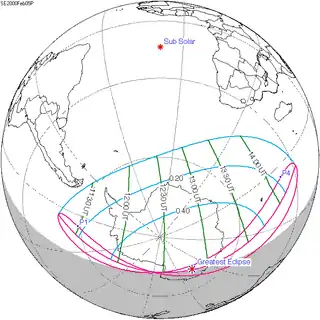 February 5, 2000 |
 November 23, 2003 |
| 154 | 156 | 158 | 160 | 162 |
 September 11, 2007 |
 July 1, 2011 |
April 18, 2015 | February 4, 2019 | November 23, 2022 |
Notes
- van Gent, R.H. "Solar- and Lunar-Eclipse Predictions from Antiquity to the Present". A Catalogue of Eclipse Cycles. Utrecht University. Retrieved 6 October 2018.
References
- Earth visibility chart and eclipse statistics Eclipse Predictions by Fred Espenak, NASA/GSFC
.jpg.webp)

